Diseases and pests of tomatoes in the open field
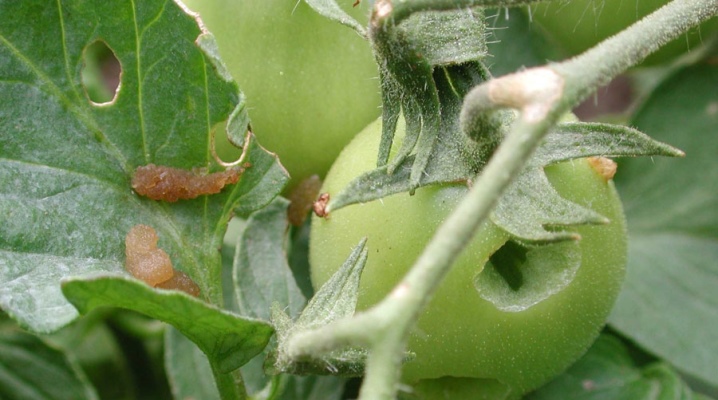
The fight against diseases and pests of tomatoes in open areas can be quite difficult. This is because nightshades are exposed to a wide variety of pathogens and insect pests. At best, their attacks reduce the quality of the number of fruits, at worst, they lead to the death of the plant.
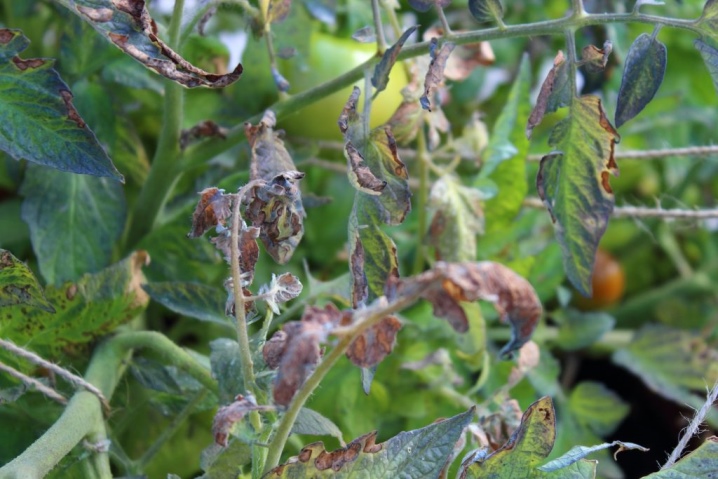
Treatment of diseases
Mosaic
A common viral disease that manifests itself in the variegation of leaves - among the dark and light green spots, yellow ones are clearly distinguishable. The virus infects the tomato bush totally. It is resistant to fluctuations in humidity and temperature influences, so it is almost impossible to get rid of it.
The only chance to protect the seedlings is to take early prevention measures. It consists in processing seedlings before planting: for this they are pickled in a pale solution of potassium permanganate.
If an adult plant is sick, then no treatments will save it. In this case, the bush should be uprooted and burned.
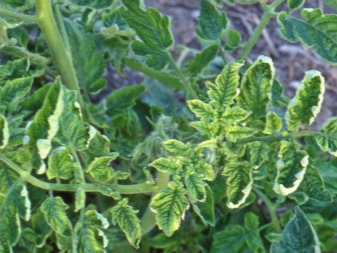

Late blight
Dark spots on the leaves are the first to indicate the presence of a fungal disease. Soon after infection, the spores transfer to the fruit, they become covered with brown marks and become unusable. The spread of the disease is facilitated by high levels of humidity and temperature fluctuations.
To protect the plants from fungus, 3 weeks after planting seedlings in open ground, the bushes should be treated with the Zaslon preparation. After another 3 weeks, the treatment is carried out with the "Barrier" agent. As soon as the seedlings bloom, the tomato brush is sprayed with an infusion of garlic: 1 cup of ground garlic is mixed with 1 g of potassium permanganate and diluted in a bucket of water. The consumption rate of the drug is 500 ml per square meter of planting.

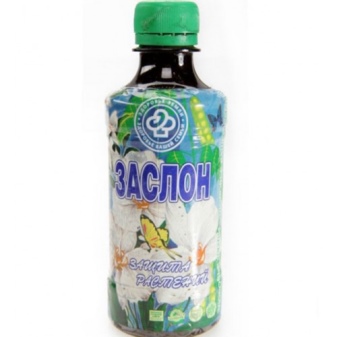
Alternaria or macrosporiosis
Fungus damage. The very first to suffer are the lower leaves of the tomato bush, brown spots appear on them, which gradually increase, and then capture the entire leaf plate, and soon after that the leaves die off. Over time, the spots on the stems transform into dry rot, its distinctive feature is the appearance of a dark gray, almost black bloom on the spots.
Most often, the disease affects early ripening tomato varieties in humid and warm weather.
As soon as you notice the first symptoms of the disease, you should immediately treat the seedlings with any fungicidal preparation. Spraying is repeated 2-3 times. In the early stages of the disease, the drug "Fitosporin" can be effective.
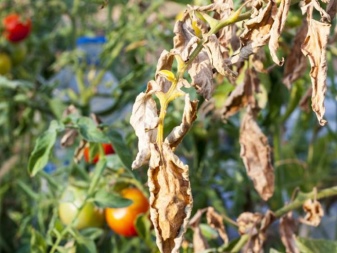
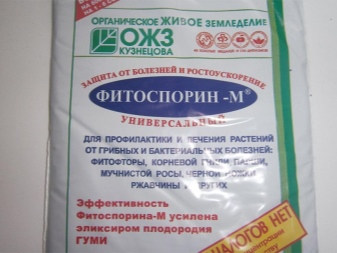
Top rot
With this pathology, black spots are noticeable on green fruits that look like they are pressed into the pulp, they can be watery, with an unpleasant putrid odor, or dry. The development of the disease is provoked by a moisture deficit, a lack of calcium and excessive application of nitrogen-containing dressings. In the early stages, tomatoes can be helped by treatment with a solution of calcium nitrate at the rate of 1 tbsp. l. on a bucket of water. If spraying does not help, then the bush should be destroyed.
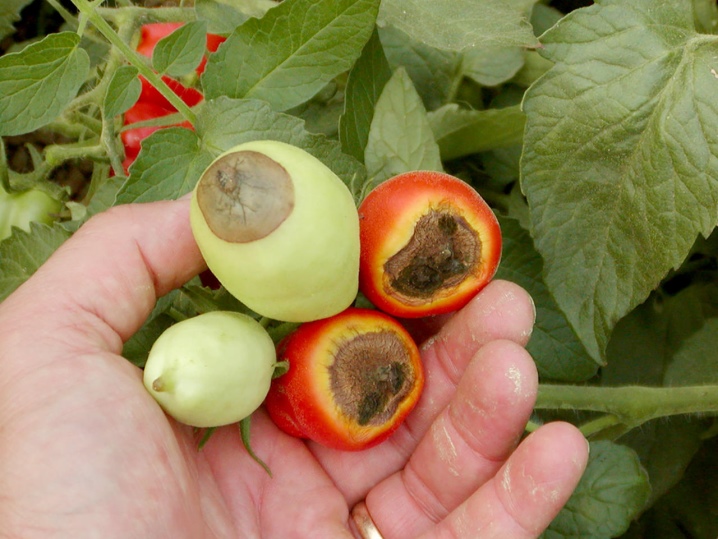
Blackleg
Fungal infection, which usually develops with an excess of mineral fertilizers and excessive moisture in the seedlings. Contaminated garden tools and soil can become carriers of the fungus, so the soil should be disinfected before planting tomatoes. Unfortunately, it is not possible to immediately recognize the disease, since the roots are the first to blacken and rot.Only after a few days it passes to the stems, at which point the process is already irreversible. The bush looks lethargic, the leaves are covered with brown spots and dry out.
Such plants are to be destroyed, and neighboring plants are sprayed with a solution of copper sulfate or "Pseudobacterin" for prophylaxis.
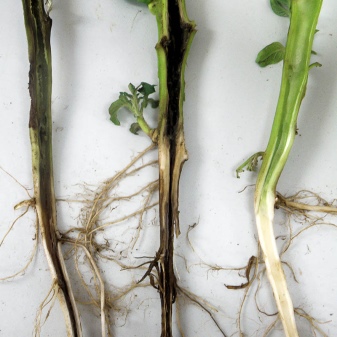
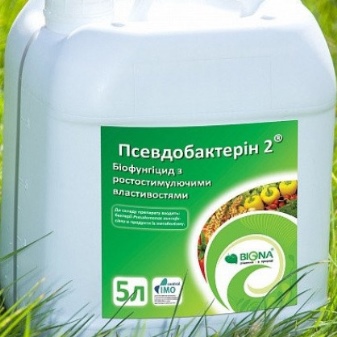
Cladosporium
This disease is often referred to as olive spot. It affects the underside of the leaves, dark brown spots with a grayish bloom appear on them. Spores are easily carried by the wind to other plants, adhere to garden tools and human clothing, so the infection quickly spreads to other plantings.
The basic preventive measure to prevent the spread of cladosporiosis is the optimization of the irrigation regime. Humidification must be performed in a timely manner, at daytime temperature and always with warm water. The preparations "Barrier" and "Zaslon" can protect tomato bushes from disease.
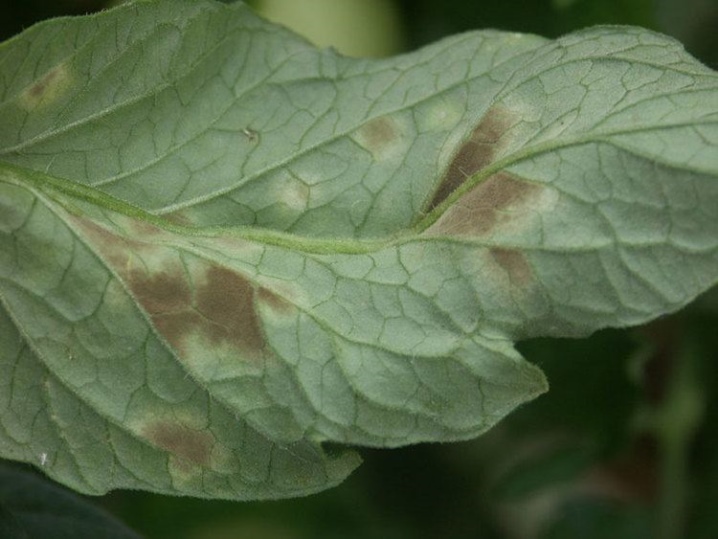
Gray rot
This fungal infection most often spreads in the last stage of the growing season, therefore, tomato fruits are affected. Cool and rainy weather becomes comfortable for the fungus. The pathology manifests itself in small spots on the skin of the fruit, which quickly increase in size. Only fungicidal preparations can save such a plant, while it is important to observe the waiting period for harvesting fruits - it should be at least a week. For the prevention of the disease, it is necessary to do spraying with "Glyokladin" or "Trichodermin".
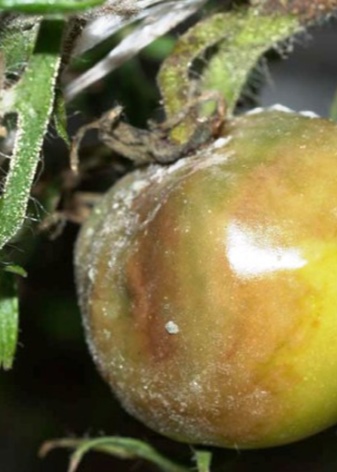
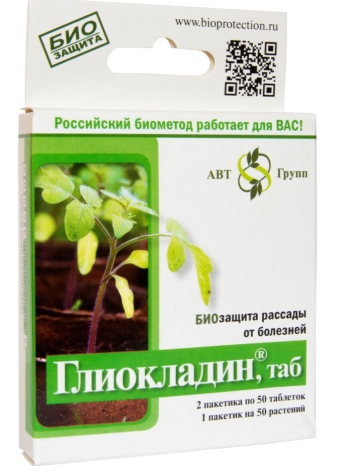
Brown rot
When infected, a brown spot appears at the base of the fetus, and then internal decay begins. If the disease first appeared on green tomatoes, they will fall off before they ripen. Affected fruits should be burned, and the bushes should be treated with Fundazol or Zaslon.
To prevent contamination of neighboring bushes, spraying with Bordeaux liquid or copper oxychloride should be carried out.

Root rot
Most often, greenhouse tomatoes suffer from this disease. In open areas, it develops with excessive watering or when planting seedlings the next year after cucumbers. Infection causes rotting of the root system - the plants begin to dry out and die.
There are no effective drugs; for prophylaxis, disinfection of the substrate with copper sulfate is used with the obligatory removal of the top layer of the earth.
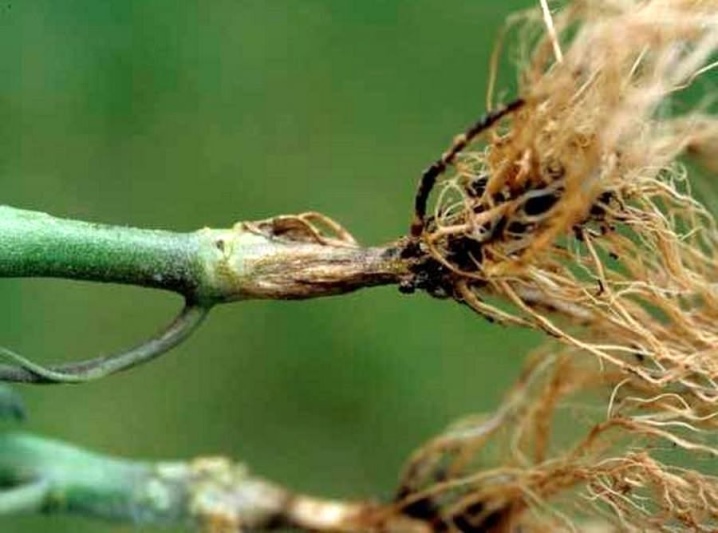
Fruit cracking
Such a disease often makes itself felt during temperature fluctuations, in hot dry weather and a lack of moisture. In addition, problems can appear after damage to the fruit as a result of excessive water pressure from the roots.
Having found any of the listed diseases on tomato bushes, the fight for the harvest should be started immediately. Any delay is undesirable, since infections spread quite quickly, especially viral ones. Sometimes just a few hours are enough for them to cover the nearby bushes and move to the next bed. The situation is aggravated by the fact that viral pathologies are not treated.
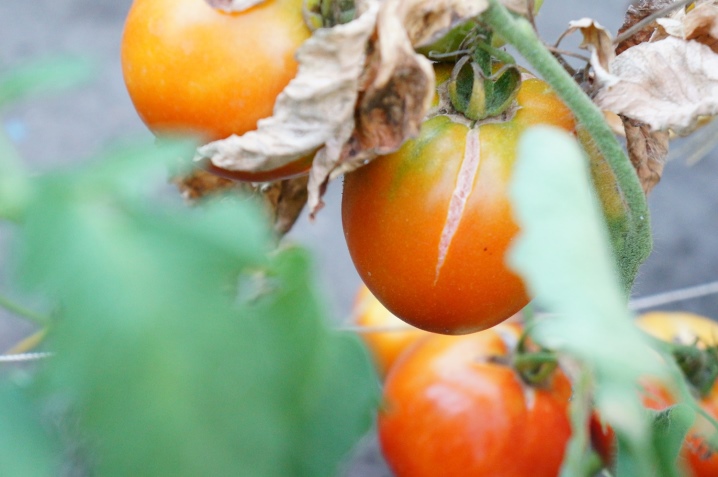
Sometimes it is necessary to destroy diseased bushes in order to protect neighboring seedlings from disease. This does not mean that you need to give up - in the early stages, some diseases can be dealt with. If the measures taken did not give the desired result, the bushes are pulled out by the roots, burned, and neighboring plants are sprayed with Bordeaux liquid or other fungicides.
For fungal infections, the forecasts are more favorable: with timely therapy, even plants with 50% damage can survive and bear fruit. In this case, it is not necessary to destroy the entire bush - only the affected branches are removed.
It should be borne in mind that most fungal diseases can be prevented by observing the rules of agricultural technology and crop rotation.
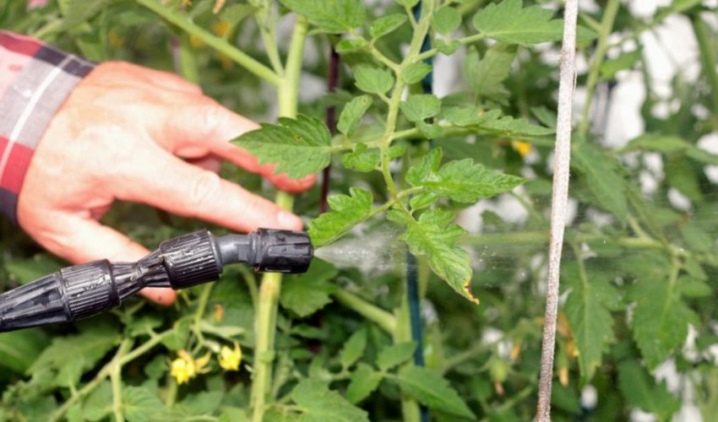
How to treat pests?
Pests are living things that use tomatoes as a habitat or as a food source.They often become carriers of dangerous viral diseases, moving from one bush to another. They spread pathogens to all bushes, and as a result, an infection of even one plant can develop into a serious epidemic.
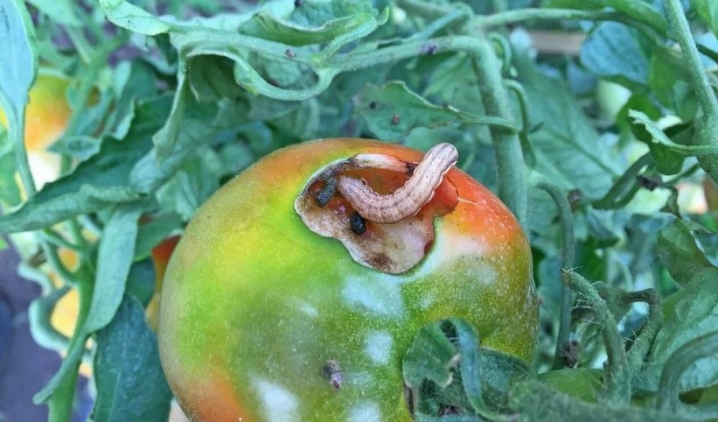
Let's list the most common tomato pests.
- Nematodes - small roundworms that parasitize the roots of tomatoes. They lead to lightning-fast wilting of the plant, in addition, they carry bacteria, infections and viruses. Treatment with "Fitoverm", "Karbofos" and "Nematofagin" helps to remove the enemy.
- Slugs are gastropods that eat the juicy fruits of tomatoes. They spoil the crop, and also infect plants with dangerous fungal diseases. Folk remedies help to cope with them - solutions of mustard, pepper and garlic, as well as chemical preparations "Thunder", "Ulicid".
- Aphid Is a small but very dangerous insect. It parasitizes on the green parts of tomatoes, lives in colonies and sucks vital juices from tomato bushes, which causes them to wilt. In addition, aphids on tomatoes often cause noticeable leaf deformation and chlorosis. Our grandparents fought with them with ammonia solution or soap composition. Modern gardeners prefer Fitoverm, Fufanon and Alatar.
- Ants - by themselves, these insects are not dangerous for tomatoes. But they spread aphids, which feed on plant juices. In addition, during the construction of an anthill, the root system is often damaged, and this leads to infection with fungal diseases. The drug "Anteater" works most effectively against ants.
- Whitefly Is one of the most serious pests of tomatoes. It parasitizes on the bottom of the leaves. The larvae feed on the green tissues of the plant, and the adult insects spread the pathogens. The drugs Biotlin, Iskra, Tanrek work best against this pest. However, this insect has the ability to quickly develop resistance to any chemical composition, therefore, to achieve the maximum effect in the fight against a garden pest, different means should be alternated.
- Thrips - these creatures live only 3 weeks, but during this time they have time to reproduce. Thrips are dangerous for tomatoes because they carry the spotted wilting virus. The fight against these pests can be effective only if started at the first manifestations of the presence of the pest; Biotlin, Alatar and Aktara are recognized as the most effective chemicals.
- Cicadas - this pest makes its moves in the green tissues of the plant and lays eggs in them. In addition, they are the causative agents of the infectious stalk and carriers of the nightshade curl virus. To combat them, the chemical compositions "Aktara", "Akkord" and "Tanrek" are used.
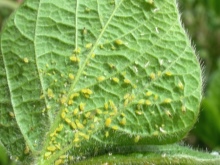

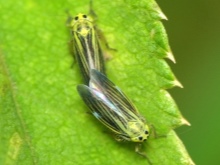
Prophylaxis
Measures aimed at preventing the defeat of tomato bushes in the open field by diseases and insect pests are reduced to three groups.
- Disinfection of seeds. Planting material is the most common carrier of most tomato diseases. Pathogens can enter seeds during storage or be transmitted genetically. To prevent the development of infection, seedlings are etched with potassium permanganate or sulfur solution before planting.
- Disinfection of garden tools. In the autumn period after harvesting, it is necessary to remove all plant residues. This will eliminate the maximum number of pathogens and pests. During this period, it is important to disinfect all structures and garden tools with water solutions "Karbofos" or "Chloroethanol".
- Chemical protection. Plants need to be treated, whether they get sick or not.
Typically, gardeners combine specialized drugs aimed at combating certain types of infection, and broad-spectrum compounds.
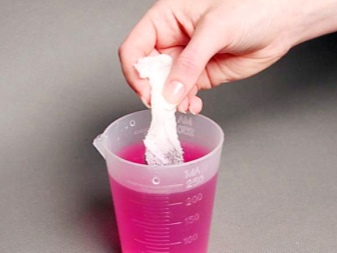
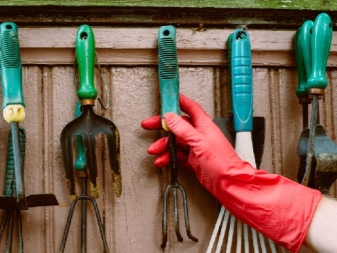
The most resistant varieties
Breeders are actively working on developing new varieties that would be resistant to the activity of fungi, viruses, bacteria and repel the attacks of garden pests.
- "Blitz" - early maturing, determinant variety. These tomatoes feel comfortable in the open field, in 90 days after planting, juicy fragrant fruits weighing up to 100 g can be harvested. This plant has a strong immunity to most of the known crop diseases.
- "Konigsberg" - mid-season hybrid. The first tomatoes can be removed as early as 110 days after planting the seeds. The variety is intended for cultivation in Siberia, so it is able to withstand the most adverse weather conditions. It is distinguished by high yield and resistance to various diseases, with proper care, up to 18 kg of fruits can be obtained from one square meter.
- "Chio-chio-san" - mid-season variety. The first tomatoes appear 110 days after planting. The fruits are small, no more than 40 g, but at the same time up to 50 pieces can form on each bush. Differs in resistance to unfavorable temperature factors, grows successfully in Siberia and the Far East. It is resistant to diseases of nightshade crops.
- "Apple tree of Russia" - mid-season hybrid, producing fruits weighing 100 g 120 days after sowing the seeds. The hybrid is problem-free, it grows well even in the most severe conditions. The plant is high-yielding, characterized by resistance to most diseases and viruses.
- "Puzata khata" - early ripe large-fruited variety. The berry ripens on the 105th day, it can reach 300 g. With proper care, up to 12 kg of tomatoes can be harvested from each bush. It has a high immunity to all infectious diseases.
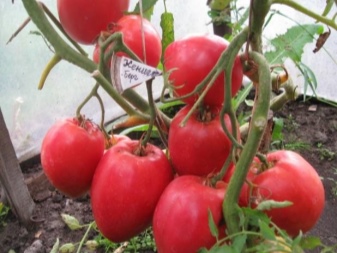
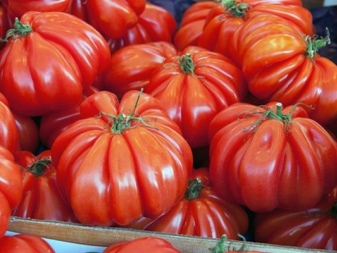













The comment was sent successfully.